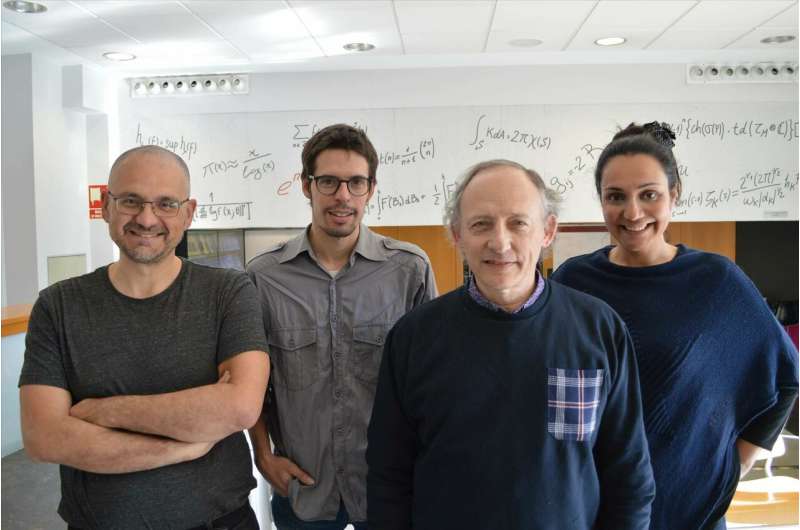From left to right: Álvaro Corral, David Moriña, Pedro Puig, Isabel Serra. Credit: Luca Tancredi (CRM)
Three mathematicians and a physicist from the Universitat Autònoma de Barcelona (UAB), the Mathematics Research Centre (CRM) and the Barcelona Graduate School of Mathematics (BGSMath) propose a mathematical model to make reliable estimations of the probability of geomagnetic storms caused by solar activity.
The researchers, who published the study in the journal Scientific Reports in February, calculated the probability of a potentially catastrophic geomagnetic storm in the next decade, like the one that occurred between the end of August and beginning of September 1859, known as the Carrington Event. That year, astronomer Richard C. Carrington observed the most powerful geomagnetic storm known to date.
According to this new research, the probability of a similar solar storm occurring in the following decade ranges from 0.46 percent to 1.88 percent, far less than the percentage estimated before. "In 2012, the results reported in scientific literature estimated the probability to be around 12 percent, 10 times more than our more pessimistic estimation," says David Moriña, first author of the study and postdoctoral researcher. "Our model is more flexible than previous ones and it also includes the model used for the previous estimations as a specific case," Moriña adds.
The intensity of solar surface perturbations such as flares and coronal mass ejections affecting the Earth's magnetosphere has been measured since 1957 using the "Dst" index, which centralises the values collected every hour in stations located across the globe. Normally, the value of this parameter ranges from -20 to +20 nT (nanoteslas, one billionth of a tesla unit; a tesla unit can be compared to the magnetic flux density generated by a powerful loudspeaker). It is estimated that the Dst index associated with the Carrington Event had a value of approximately -850 nT.
Geomagnetic storms are responsible for spectacular phenomena such as the aurora borealis observed at the Earth's highest latitudes, which depending on their intensity can interfere drastically with human activity. Examples of severe disruptions occurring in past decades are the interruption of electrical and navigation systems and satellite communications.
"In Carrington's time, the only infrastructure affected was the global telephone network," says mathematician Isabel Serra, a co-author. "Now, a storm of such intensity could have catastrophic effects on our society. According to a 2013 study conducted by the Lloyd's of London insurance company and Atmospheric and Environmental Research, the duration of these effects could last longer than a year, and costs could rise to $2.5 trillion. These are numbers that should make us think."
"A probability close to 2 percent, which is what we have calculated for a highly intense storm, should not be overlooked if we take into account the consequences of such an event," says Professor Pere Puig, one of the authors of the paper. "Governments should have action protocols to react to such disasters in order to inform and calm the population left without electrical energy and no way to communicate. We cannot forget that there will be very little time to react before the unforeseen arrival of this type of storm."
More information: David Moriña et al. Probability estimation of a Carrington-like geomagnetic storm, Scientific Reports (2019). DOI: 10.1038/s41598-019-38918-8
Journal information: Scientific Reports
Provided by Autonomous University of Barcelona
























